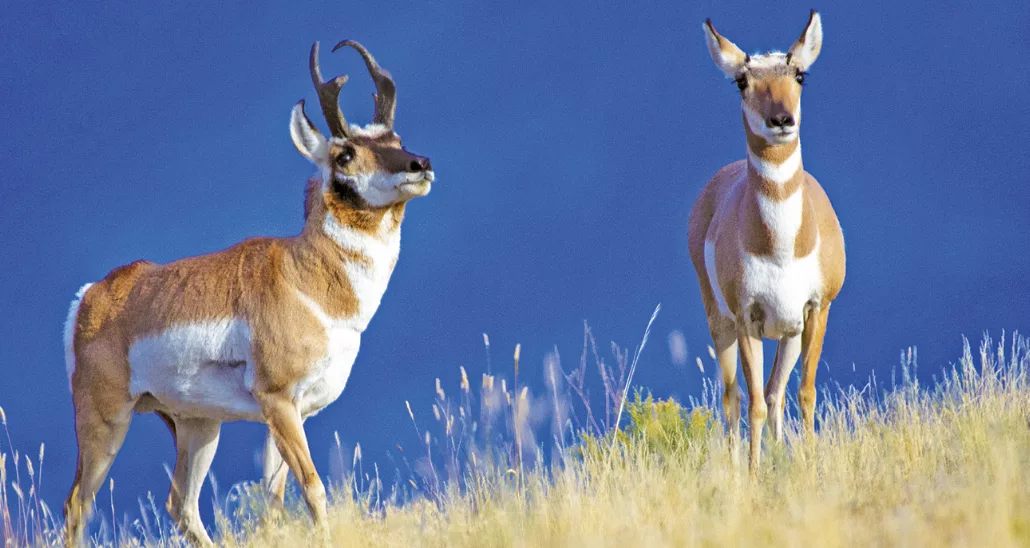
By Jim Knox
We had passed beneath the iconic Roosevelt Arch into the North Entrance of Yellowstone National Park just moments before. Our gaze was filled with open vistas beyond. Brimming with unbridled wonder, our minds conjured images of world-famous wildlife around each bend of the park’s gentle switchback road and pristine wilderness awaiting us over the horizon. Yet, we didn’t have to climb the first foothill to experience the park. “The park” stood before us, in the form of a small herd of creatures standing peacefully 150 yards to the south. Alternating between scanning and grazing, the delicate looking cream and tan animals commanded our rapt attention—14 pairs of eyes locked on the small band.
The Pronghorn, (Antilocapra americana) sometimes referred to as the Pronghorn Antelope or Prongbuck, is a creature which eludes convention. While its scientific name means the American antelope goat, it is neither antelope nor goat, yet it is certainly an American original. A holdover from the Pleistocene, the Pronghorn possesses features of its antelope and goat cousins, as well as deer. Yet its closest living relatives are actually the Okapi and giraffe species. This uniqueness confers special abilities akin to animal superpowers.
At three feet at the shoulder and weights averaging 125 pounds, these slender herbivores appear delicate and deer-like. Despite this similarity, they are utterly unique. Pronghorn hold the distinction of being the world’s only mammals which shed their horns. Females and males alike sport the horns, which form as cemented hairs. While females grow small spikes, Males can grow the blackish horns to a length of more than 1 foot. This defensive adaptation enables Pronghorn bucks to spar to demonstrate fitness to the does during courtship, and to protect themselves and their fawns from predators.
Sporting slim bodies with long slender legs, coupled with white hairs on their bellies, lower flanks, necks, and rumps, and tan hair on their legs, upper flanks, backs, and napes, Pronghorns are conspicuous. With prominent bands of black hair beneath their jaws, on their noses and along their brow ridge, these hoofed creatures seem to pose for the lens.
Pronghorn are not simply swift, they are among the planet’s fastest land mammals. A mere stride or two behind Africa’s 70-mile-per-hour-world-record-holding Cheetah, North America’s Pronghorn blazes across prairies, scrublands, and deserts at an astonishing 61-miles-per-hour! What’s more, while the Cheetah is a sprinter, the long-distance Pronghorn can maintain elevated speeds of more than 40 miles per hour (as fast as a racehorse) for miles! A closer look reveals the mechanics behind super speed and adaptations for a life on the run honed over countless generations.
As the only surviving member of the Antilocapridae Family, Pronghorn have carried a host of elite high-speed adaptations forward since the Pleistocene. Their finely pointed and cushioned hooves grip the ground and absorb the shocks of impacts to their frame as they course over hardened uneven terrain. Their enlarged lungs cycle increased oxygen flow, bringing highly oxygenated blood to their enlarged hearts, which in turn pump blood more rapidly throughout their fleet frames. Lack of a collarbone affords them greater range of limb motion and stride length—up to 20 feet per stride! This unique anatomy also improves running efficiency and enables more rapid striding. Truly born to run, Pronghorn fawns can outrun even the fastest humans less than two days after they are born! Other than an occasional Mountain lion, healthy adults have no natural predators.
Yet, there is more to these ice age survivors than mere speed alone. Possessing keen eyesight, the largest eyes of any of North America’s hoofed mammals for their body size, and prominent eye placement which affords them a sweeping 300 degrees of vision, Pronghorn can detect movement more than 4 miles away! Their vision superpower couples with their early warning system—brilliant white rump hairs which raise to signal danger as a “hair flash.” In this way, Pronghorn detect warning, give warning, and make tracks, putting a healthy distance between the herd and potential predators.
With hollow hairs which insulate them from deadly temperature extremes ranging from 50 below zero to a deadly 130 degrees above, Pronghorn are as hardy as they come. As the one of the only animals of the American West capable of eating Sage—and even poisonous Paper Flower and Woolly Senecio—Pronghorn survive in ranges where other wildlife would perish!
Demonstrating nature’s version of superpowers, Pronghorn inspire us with their sensory abilities, extraordinary swiftness, and beauty. In a world where we are increasingly called upon to utilize our own special abilities to navigate ever more challenging landscapes, the Pronghorn serves us well as our guide. Banding together to enhance vigilance, they stand as one and remain ahead of danger. Yet, when they encounter obstacles, they invariably take them “in stride.”
Jim Knox serves as the Curator of Education for Connecticut’s Beardsley Zoo and as a Science Adviser for The Bruce Museum. His passions include studying our planet’s rarest creatures and sharing his work with others who love the natural world.


